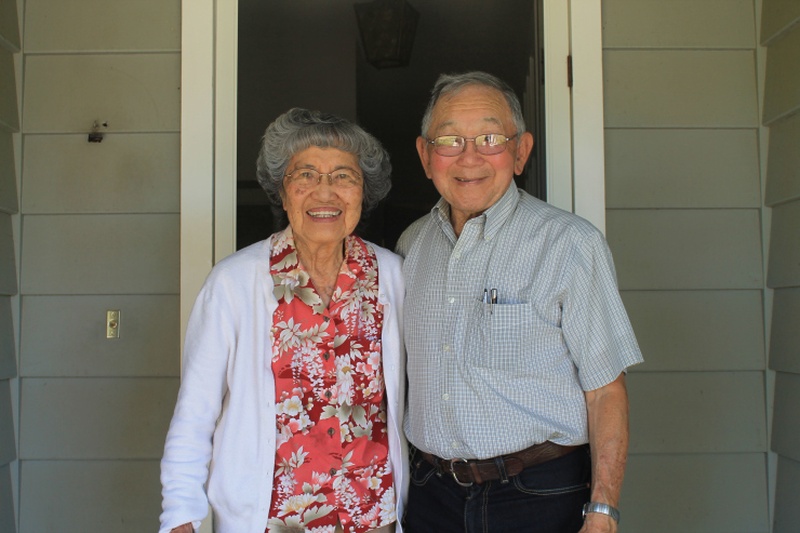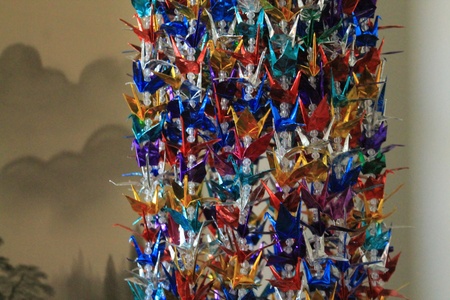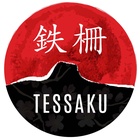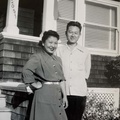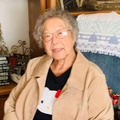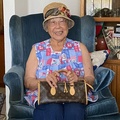"After they gave us the redress, it just really relieved all of us who had been in the camp. Because camp was sort of a feeling of shame, that you had to be in a place like that. So we didn’t talk about it.”
— Sherman Kishi
Down a tucked away country road in Livingston, California sits a ranch-style house, welcoming guests with a driveway full of poppies. Adjacent to this house lies lush farmland filled with almond trees and fields of sweet potatoes. This land, and its 230 acres, belong to the Kishi family, who have looked over it and cultivated produce from it for over 100 years. A strong co-op and excellent planning allowed the Kishis and other Japanese American farmers in the area–called Yamato Colony–to keep their land throughout the war. “Everyone got their land back, we all had our property back. The manager of the trusteeship came to camp several times during the war years to report on what he was doing,” says Sherman, one of the Kishi brothers who has since retired from farming. What started off as grapes on 40 acres purchased by Sherman’s father in the early 1900s turned into a renowned agricultural mecca of Japanese sweet potatoes (satsumaimo) and almonds.
At 92 years old, Sherman is retired from farming but remains an active leader in the Central Valley Japanese American community, giving numerous talks throughout the year about his time spent in Granada (Amache) in Colorado and spearheading historical projects like the Merced Assembly Center Memorial. As a veteran of the Military Intelligence Service (MIS), Sherman was awarded the Congressional Gold Medal from President Obama in 2010, a testament to his invaluable service as a translator/interpreter in the Pacific theater.
I interviewed Sherman at his beautiful Livingston home, where he’s lived with his wife, June since 1946. Longevity and deep roots seem to be a cornerstone of the Kishi’s life: The house where Sherman was born still stands across the street and this year, Sherman and June will celebrate their 72nd anniversary. “Most people don’t make it that long,” he says.
* * * * *
When did your family first migrate to America?
My father came to the United States in 1903 when he was 18 years old. And he came into Seattle and came down into California as a farm laborer and he was up and down the Valley for a number of years. I think between 1910 and 1913 he settled here in Livingston. My mother was a picture bride, basically. I think the families knew each other in Japan and it was arranged there. She was teaching in Japan and she left teaching and came to the United States and stayed here all the rest of her life.
Do you know why your father came to the United States?
I know the reason. My father went with his cousin to Tokyo from Wakayama to take a test to get into the military, to be officers in the military. And he passed the written test very well but he had one deaf ear. So he was rejected for service, thank goodness. So he didn’t go home to Wakayama before he left for the United States. He was so disappointed, I guess. And the cousin that he had was inducted into the military and became a general before the war. He just left Japan.
So your father was completely by himself?
Yes, as far as I know by himself.
So he made it down to this area, and he began to farm because that’s what everyone else was doing?
Up and down the valley was lots of farming, seasonal of course. They commuted up and down the valley and he made friends as he was doing that.
So he bought this property?
This area is called Yamato Colony. Mr. Abiko from San Francisco came to the United States in about 1885 and he was a relatively well-educated man and became involved in the newspaper. In fact he started the Nichi Bei.
He and some friends saw these migrant workers going up and down and spending their money in San Francisco, blowing it. So I guess that’s why he thought he’d start a community. And several of them talked about it and became friends and decided they’d look for a place to start a community. And they came down into the valley, looked around, and decided on Livingston because the water was so good. And so they bought I think 2,000 acres to begin with and opened it up for Japanese people to immigrate into. And they sold the land to the people who came in. It actually started with two communities–there’s a Cressy, which is adjacent to Livingston. This is in 1906 that it began just at the time of the earthquake. And so there were about six or seven families who came after the earthquake into Livingston.
And it’s interesting that this is one community that never had a Buddhist Church in it. In all the years we’ve been in it, it’s always been a Christian church. Abiko was also a Christian and so, it became a Christian community. It’s been that way ever since.
And why the name Yamato?
Yamato of course is Old Japan. But that’s not why they started it that way. There was what they called a yam station just north of Atwater and Abiko had gone up and down the area looking for a place to settle. So he took that name–the “yam station,” plus Atwater–and made a Yamato out of it. That’s the story that we hear. This area is very famous for sweet potatoes. It’s probably the center of sweet potatoes for California. And California raises probably the third state in sweet potato production.
So what do you grow on your farm?
Things change over the years. When they first started, they first started with grapes, that was the main crop in the old, old days. In order to survive until the grapes came into the bearing, they used to raise sweet potatoes and strawberries in-between. Before the war, the grape price became so bad, it rarely made any money. But during the wartime years, the price went sky high and people with grapes made a lot of money.
We were gone but fortunately in Livingston, Cressy and Cortez, we were very active in cooperatives. Livingston had its first selling cooperative started in 1915. When 9066 was signed, there was a curfew and they said you can’t go more than five miles. But Livingston is about five miles from Cressy, and Cortez was about four miles; it was about four miles from each side. So they got together and decided that they would form a trusteeship. They hired a gentleman who worked for Bank of America for many years and he ran the trusteeship and so all the land that was in the cooperatives was protected during the war years.
They leased it out to other people and they had a couple of two or three friendly men that were the trustees and there was a manager who was hired to operate all this. And he ran it and did very well. There was a very trusted secretary that was part of the co-op before the war and she watched it carefully and made sure that everything was okay. And everyone got their land back, we all had our property back. And actually, the manager of the trusteeship came to the camp several times during the war years to report on what he was doing.
All the way to Colorado?
All the way to Colorado, yep. So that worked out very well. Some ranches weren’t kept up too well, others were kept up quite well. But the mortgages that had to be paid were paid, and the taxes were paid so nobody lost their land. It was very well thought-out and worked out very well in Livingston, Cortez and Cressy.
Because of that, was your father and your family more relaxed when they went into camp?
They didn’t know how it was going to work out, basically. They hoped it would work out well, I’m sure. But at least something was done to all the farms, as opposed to individual farmers trying to do what they could. So that worked out very well. But my father had a little out with the cooperative before the war. So he wasn’t a part of the co-op. But we found a teacher at the high school and we didn’t know he was a Mormon, a Latter Day Saint. And we asked him to run our ranch for us and he did a good job and put money in the bank for us. So we were very fortunate and had all our land back.
When they came to recruit in the camp, the first group that came in was to recruit was for the 442. And a lot of my friends went into the 442nd Regiment. And they came in just shortly thereafter looking for people for MIS, Military Intelligence Service. They started that in San Francisco, and before the war. I think in October of 1941, the school was started and it became the head of the language part was John Aiso, he became a Lieutenant Colonel in the end. Soon as the Japanese people moved, they had to do something. So they moved the camp to Camp Savage in Minnesota. When I enlisted in November of 1943, I was sent to Camp Savage to learn the language.
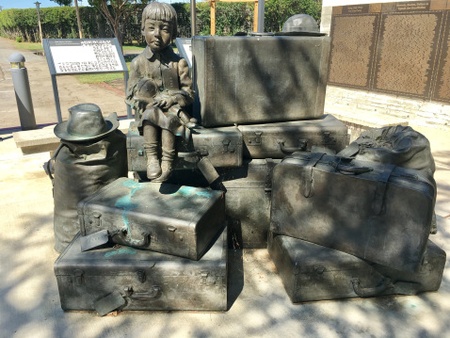
When the loyalty questionnaire came out, how did your family answer?
I think my family all answered yes. I’m not sure what my father did, because they were Isseis. If they answered yes, especially on the second question, they wouldn’t have a country, since they couldn’t become citizens. I’m not sure how he answered. But I did talk to my father before I went into the service and he said, “This is your country. If that’s what you want to do you just go ahead.” So he accepted my going into the service.
Were your parents ever worried for you going into the military?
I have no idea how they felt about it, really.
So you had friends that were also going to the MIS?
Most of my MIS friends. The draft was cut off when 9066 happened, there was no longer a draft for the Japanese. And it didn’t come back until January of 1944. So I volunteered before the draft was started. After the draft was started, there were quite a number of people who went to MIS language school in ’45 and ’46, and of course the war was over in ’45. So there were friends of mine that went to language school but I’m not sure how much they learned or anything, I was gone by then.
Can you describe your training for this intensive Japanese school?
That was the toughest school I ever went to–it was tough. We had to learn a set number of Kanjis, in a certain period of time. Now the Hawaiian kids had no problem really because they learned a lot of Japanese in Hawai’i. So most of my friends were Hawaiian kids but those of us from the states and didn’t have much Japanese, we studied with flashlights, in the bathroom after lights went out. Oh yeah, we did a lot of that.
Was Kanji the hardest part for you?
Oh yeah. It was very difficult.
And who were the teachers?
The teachers were almost all Kibeis who had gone to Japan and were educated. This John Aiso, who became the head of the language school, was really a well-educated man. He had gone back to Japan, went to college, learned Japanese, and also went to college here. They found his record and got him. They had to convince him to stay in the service because he was almost out of the service, I think he was well in his late 20s. So they convinced him to stay and become the head of the language school. He became a judge later after the war.
*This article was originally published on Tessaku on June 26, 2017.
© 2017 Emiko Tsuchida


